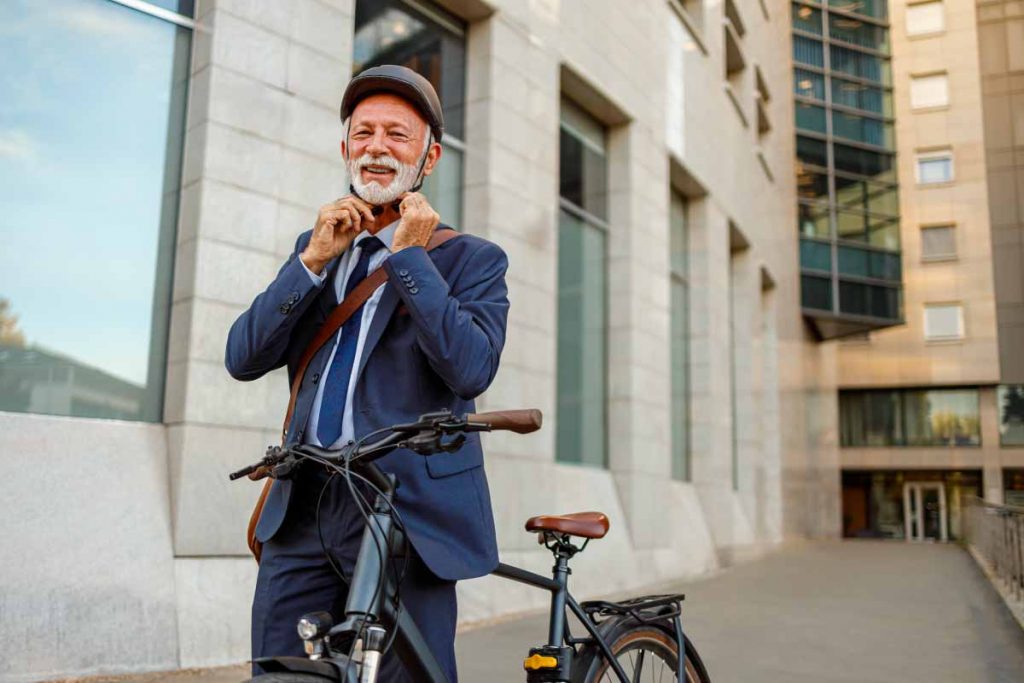
Climate change is a global problem. Therefore, many people believe that saving CO2 in everyday life has no significant impact. But that is not true. Many of our actions cause CO2 emissions: what we eat, how we travel, and what we buy. That’s why we can make a difference every day. It’s not about doing without but about recognizing and adopting climate-friendly behavior. This is where the CO2 challenge comes in. It conveys valuable knowledge and motivates employees through gamification to turn this knowledge into concrete actions in playful competitions.
What is a CO2 challenge?

There are also many opportunities for climate-friendly actions when doing daily shopping.
A CO2 challenge is a way to make climate protection tangible in companies and to motivate employees to adopt environmentally friendly behavior and achieve concrete CO2 savings. At its core, it is about measuring the greenhouse gas carbon dioxide saved through sustainable mobility and conscious behavior and rewarding it in a playful team or individual competition.
The challenge considers distances covered on foot, by bicycle, or by public transport, evaluating the savings compared to using a car. The focus of a CO2 challenge is on employee mobility—both for business and private purposes. Companies can choose between challenges that count only CO2 savings and challenges that calculate the CO2 balance. In CO2 balance challenges, emissions from car trips and flights are also included.
In addition to mobility, other aspects such as meat-free nutrition, energy-saving behavior, and the individual home office CO2 balance can be integrated. These comprehensive possibilities make the sustainability initiative not only a climate protection tool but also a platform for movement motivation, team building, and sustainable behavioral change.
CO2 fasting means a conscious renunciation.
CO2 fasting is a conscious renunciation of activities that cause high CO2 emissions. In the context of a CO2 challenge, this could mean leaving the car parked, avoiding air travel, or trying a vegetarian diet. CO2 fasting is an effective way to reflect on one’s lifestyle, raise awareness of climate change and find more sustainable alternatives.
Practical tips to save CO2 in everyday life
CO2 savings start with small, conscious decisions that can have a big impact in everyday life. Here are some simple yet effective tips:
- Rethink mobility: Use a bicycle or walk for short distances. For longer trips, public transport is often not only more environmentally friendly, but also less stressful than driving a car.
- Cook and shop consciously: A plant-based diet not only saves CO2, but is also healthy. Buying regional and seasonal products reduces the energy required for transport and storage.
- Save energy at home: Make sure devices are switched off instead of left on standby. Pay attention to efficient ventilation and heating. A quick check of the windows before leaving a room saves energy and lowers costs.
- Sustainable consumption: Choose quality over quantity. Repair broken items instead of immediately replacing them. Second-hand clothing and eco-friendly products are also great choices.
- Reduce single-use products: Avoid plastic whenever possible and use reusable containers, bottles, and bags. This not only conserves resources but also reduces waste.
- Make home office more sustainable: Use energy-efficient devices and be mindful of heating and electricity consumption. Opt for LED lighting and consider smart plugs or timers to further reduce energy usage.
A CO2 challenge allows everyone to contribute to being more sustainable in the company.
Sustainability does not stop at the office door—there are numerous ways to save CO2 in the workplace. These measures not only reduce CO2 emissions but also conserve resources and lower operating costs, making sustainability an integral part of everyday office life! Here are some simple actions that everyone can implement at work:
- Energy-efficient lighting: Use natural light as much as possible and turn off lights when they are not needed. LED lamps are an energy-efficient alternative to traditional bulbs.
- Use devices consciously: Turn off computers, monitors, and other devices completely after work. Use power strips with switches to easily disconnect devices from electricity.
- Go digital: Reduce paper consumption through digital workflows. If printing is necessary, use recycled paper and print double-sided.
- Heating and ventilation: Keep windows closed when the heating is on and ventilate efficiently with short bursts of fresh air. Lowering the room temperature by just 1°C already saves energy.
- Promote sustainable mobility: Form carpool groups or use public transport, bicycles, or the Changers Fit app to commute to work. Companies can also offer job tickets or bike leasing programs.
- Small changes, big impact: Provide reusable containers for drinks or lunch to avoid single-use plastic. Water dispensers and refillable bottles help reduce waste.
- Plants in the office: Green up your workspace! Plants improve air quality, contribute to CO2 reduction, and promote well-being.
- Efficient meetings: Hold virtual meetings to avoid business trips. If travel is unavoidable, choose the train over the plane whenever possible.
- Raise awareness: Share tips with colleagues and integrate sustainability into internal initiatives or challenges. The Changers app can help promote such initiatives and provide measurable results.
Planting trees for the climate as a reward for participants in a zero carbon challenge.

Planting trees together with the local population and the NGO Wells for Zoe in Malawi.
A special highlight of zero carbon challenges is the opportunity to actively contribute to reforestation through sustainable behavior. Participants can plant trees by covering 100 kilometers on foot, by bicycle, or by public transport. Each planted tree is displayed virtually and later planted in a real climate protection project, which can be chosen by the company or the participants. A single tree is valued at a CO2 saving of 200 kg. A tangible goal that provides additional motivation.
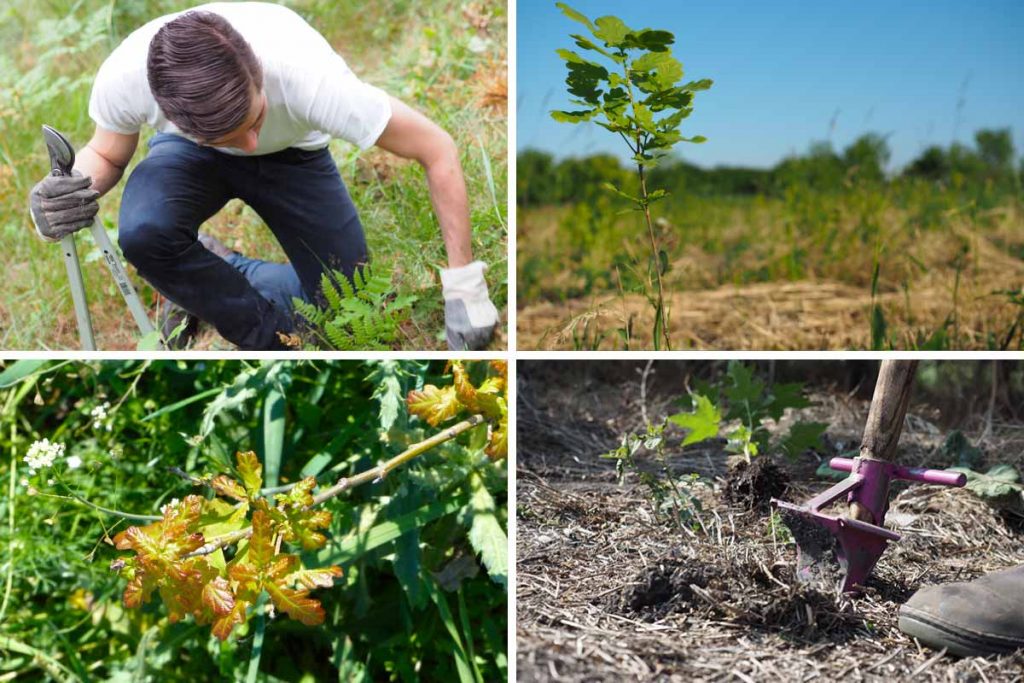
Planting trees in a CO2 challenge in Germany with Iplantatree.org.
The Changers Fit app makes this connection between individual behavior and global impact possible. It tracks participants’ CO2 savings, rewards sustainable activities, and documents progress in a playful and motivating way. With the app, companies can easily inspire their employees to engage in sustainability while simultaneously strengthening environmental awareness.
Tracking and reducing the home office CO2 footprint.
Working from home can have a significant impact on an individual’s CO2 footprint—and the Changers app helps make this impact transparent. With a dedicated feature, employees can calculate their home energy consumption and see how heating, electricity usage, and other factors affect their CO2 balance. This insight raises awareness for sustainable behavior in the home office, such as using energy-efficient devices, heating consciously, or switching to green energy. The biggest lever for CO2 savings is the reduction of commuting emissions.
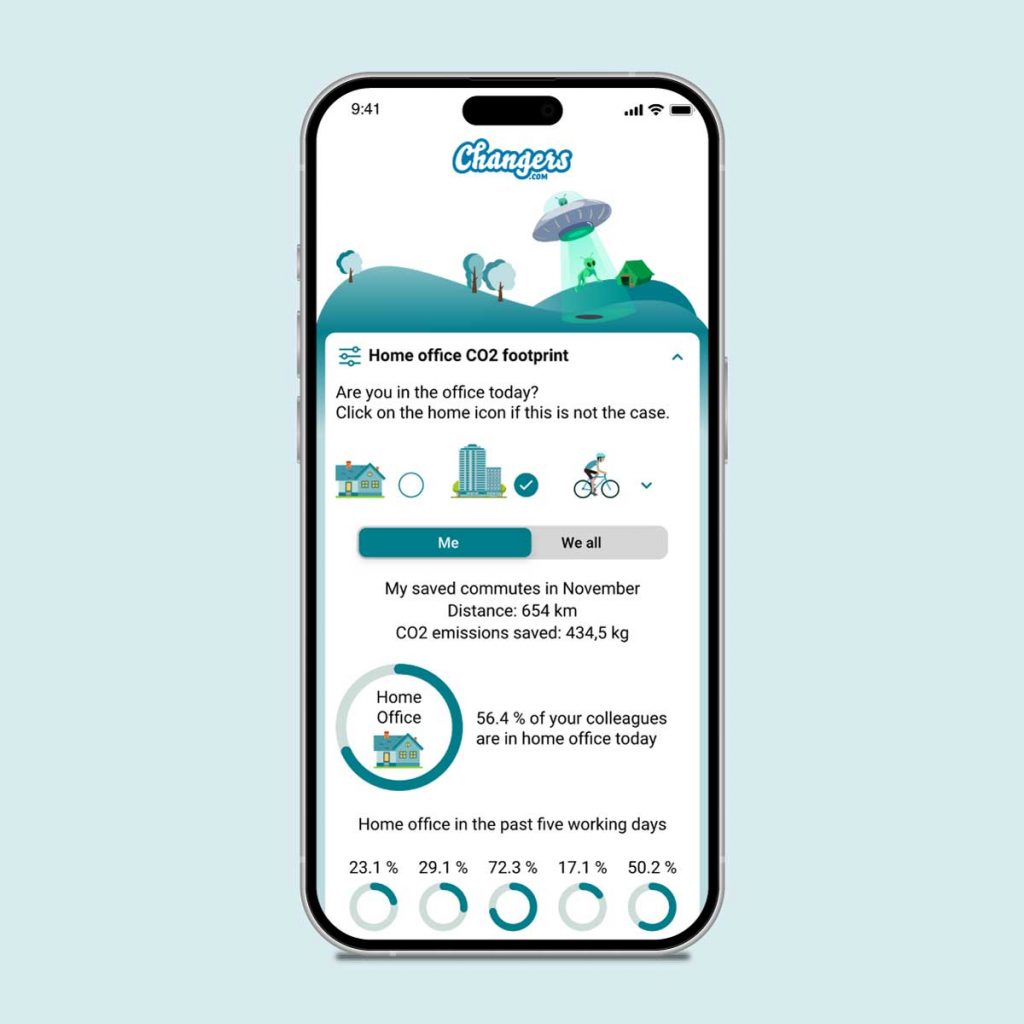
CO2 challenges in companies can also track employees’ CO2 balances in the home office using the Changers Fit app.
Companies can further create incentives by integrating sustainable behavior in the home office into their CO2 challenges. This way, working from home becomes part of the overall strategy for CO2 reduction and climate protection.
Summary: A first step toward a CO2 Challenge
A CO2 challenge offers companies a unique opportunity to combine climate protection and health promotion. With the Changers Fit app [https://changers.com/changers-fit-app/], employees can reduce their CO2 footprint through sustainable mobility, energy-saving behavior, and conscious choices. From using bicycles or public transport to optimizing home office energy consumption and adopting a meat-free diet—the challenge demonstrates how everyone can contribute.
Particularly motivating are reward systems such as tree plantings or CO2 certificates, which make achievements tangible and further encourage sustainable actions.
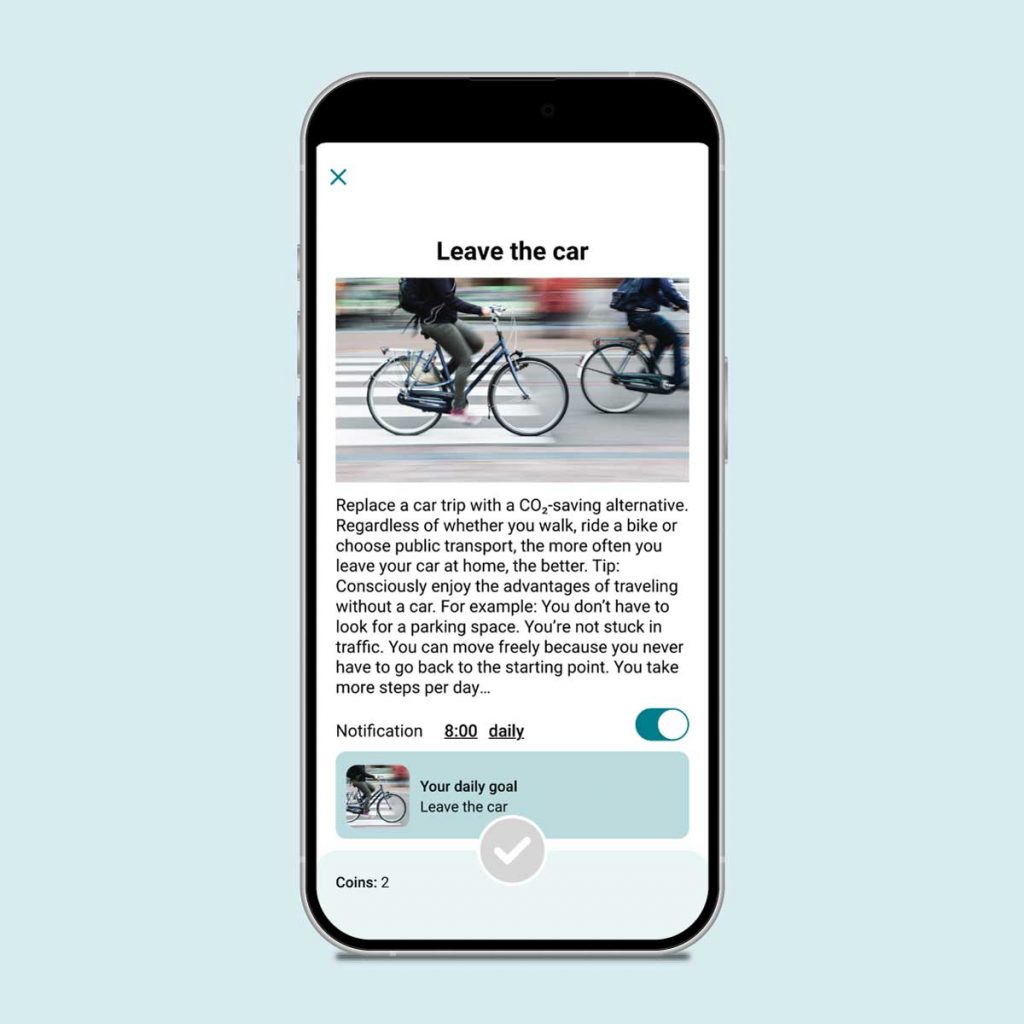
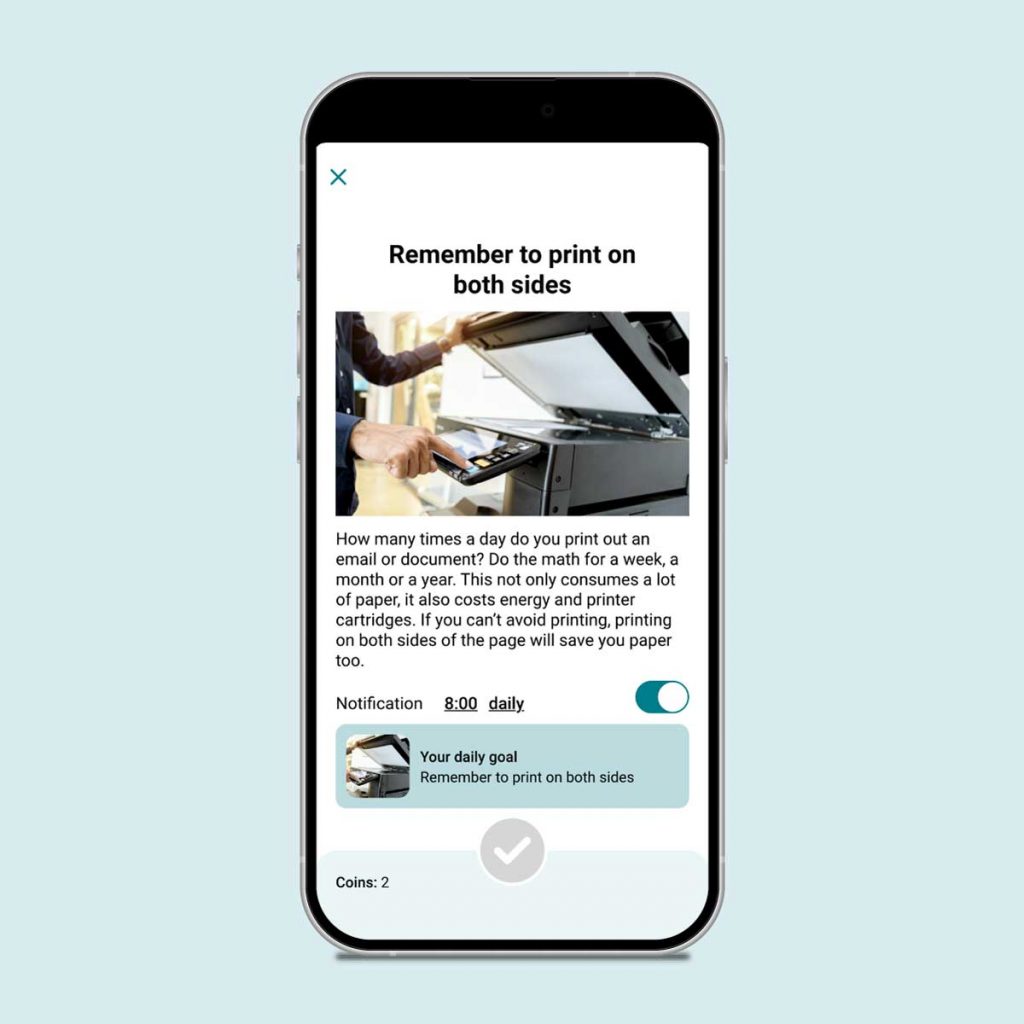

A variety of climate-friendly actions are already integrated into the Changers Fit app for a CO2 challenge. Employees can set push notifications to remind themselves to take action.
An easy way to start a zero carbon challenge is with a step challenge or a cycling challenge, encouraging participants to be more active and leave their cars behind. These challenges not only promote health but also raise awareness of the impact of daily choices on the climate. Companies that start this way can gradually expand their initiatives into a comprehensive CO2 challenge, step by step engaging their workforce in climate protection.
The CO2 challenge is more than just a competition—it is a catalyst for sustainable action and shared responsibility. With measurable results, motivating incentives, and the promotion of a sustainable corporate culture, companies and their employees can make a real difference for the planet together.
Do you have any questions? Feel free to contact us!
We look forward to getting to know you. Let’s set up your first CO2 challenge together in your company.
Daniela Schiffer
d.schiffer@changers.com
+49 172 367 40 38


